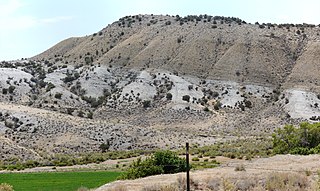| Skull Creek Shale | |
|---|---|
| Stratigraphic range: Albian around | |
| Type | Formation |
| Lithology | |
| Primary | shale |
| Location | |
| Region | Nebraska |
| Country | United States |
The Skull Creek Shale is a Cretaceous geologic formation in Wyoming as well as Colorado and Nebraska, United States. [1]
The Skull Creek Shale corresponds with the Kiowa Shale. [1]

The Dakota is a sedimentary geologic unit name of formation and group rank in Midwestern North America. The Dakota units are generally composed of sandstones, mudstones, clays, and shales deposited in the Mid-Cretaceous opening of the Western Interior Seaway. The usage of the name Dakota for this particular Albian-Cenomanian strata is exceptionally widespread; from British Columbia and Alberta to Montana and Wisconsin to Colorado and Kansas to Utah and Arizona. It is famous for producing massive colorful rock formations in the Rocky Mountains and the Great Plains of the United States, and for preserving both dinosaur footprints and early deciduous tree leaves.

The Fox Hills Formation is a Cretaceous geologic formation in the northwestern Great Plains of North America. It is present from Alberta on the north to Colorado in the south.

The Mowry Shale is an Early Cretaceous geologic formation. The formation was named for Mowrie Creek, northwest of Buffalo in Johnson County, Wyoming.
The Kiowa Formation or Kiowa Shale is a Cretaceous geologic formation in Kansas, diminishing to member status in Colorado and Oklahoma. In Colorado, the Kiowa Shale was classified as a member of the now abandoned Purgatoire Formation. In the vicinity of Longford, Kansas, the local Longford member comprises thinly bedded siltstone, clay, polished gravel, lignite, and sandstone suggests a river and estuary environment.

The Carlile Shale is a Turonian age Upper/Late Cretaceous series shale geologic formation in the central-western United States, including in the Great Plains region of Colorado, Kansas, Nebraska, New Mexico, North Dakota, South Dakota, and Wyoming.

The Mancos Shale or Mancos Group is a Late Cretaceous geologic formation of the Western United States.
The Black Mingo Group is a geologic group in South Carolina composed of dark grey to black clays, shales, laminated sandy shales, and yellow-red sands. The group's name comes from Black Mingo Creek where outcrops of the group are exposed. The bottom boundary is an unconformity with Cretaceous deposits. It preserves fossils dating back to the Paleogene period.

The Graneros Shale is a geologic formation in the United States identified in the Great Plains as well as New Mexico that dates to the Cenomanian Age of the Cretaceous Period. It is defined as the finely sandy argillaceous or clayey near-shore/marginal-marine shale that lies above the older, non-marine Dakota sand and mud, but below the younger, chalky open-marine shale of the Greenhorn. This definition was made in Colorado by G. K. Gilbert and has been adopted in other states that use Gilbert's division of the Benton's shales into Carlile, Greenhorn, and Graneros. These states include Kansas, Texas, Oklahoma, Nebraska, and New Mexico as well as corners of Minnesota and Iowa. North Dakota, South Dakota, Wyoming, and Montana have somewhat different usages — in particular, north and west of the Black Hills, the same rock and fossil layer is named Belle Fourche Shale.

The Greenhorn Limestone or Greenhorn Formation is a geologic formation in the Great Plains Region of the United States, dating to the Cenomanian and Turonian ages of the Late Cretaceous period. The formation gives its name to the Greenhorn cycle of the Western Interior Seaway.
The Inyan Kara Group is a geologic group classification applied in South Dakota and adopted in portions of Wyoming and Montana. It preserves fossils of the mid-Cretaceous period. Of late Albian age, this classification correlates with the lower Dakota Formation known in the southwest corner of the State.
The Janesville Shale or Janesville Formation is a geologic formation in Kansas, Oklahoma, and Nebraska dating to the late Carboniferous period.
The Council Grove Group is a geologic group in Kansas, Oklahoma, and Nebraska as well as subsurface Colorado. It preserves fossils dating to the Carboniferous-Permian boundary. This group forms the foundations and lower ranges of the Flint Hills of Kansas, underlying the Chase Group that forms the highest ridges of the Flint Hills.

The Benton Shale is a geologic formation name historically used in Montana, Wyoming, North Dakota, South Dakota, Colorado, Kansas, and Nebraska. In the "mile high" plains in the center of the continent, the named layers preserve marine fossils from the Late Cretaceous Period. The term Benton Limestone has also been used to refer to the chalky portions of the strata, especially the beds of the strata presently classified as Greenhorn Limestone, particularly the Fencepost limestone.
The Belle Fourche Formation or Belle Fourche Shale is a fossiliferous early Late-Cretaceous geologic formation classification in Wyoming. Named for outcrops in Belle Fourche River, Wyoming, this unit name is also used in Montana, North Dakota, and South Dakota.
The Aspen Shale is a geologic formation in Wyoming, United States. It preserves fossils dating back to the Cretaceous period.
The Newcastle Sandstone is a geologic formation in Wyoming, United States. It preserves fossils dating back to the Late Cretaceous period.

The Lewis Shale is a geologic formation in the Western United States. It preserves fossils dating back to the Campanian to Maastrichtian stages of the late Cretaceous period.
The Tucumcari Formation is a geologic formation in New Mexico. It preserves fossils dating back to the Albian Age of the early Cretaceous period.
The Florena Shale is a stratigraphic unit in east-central Kansas, northeast-central Oklahoma, and southeastern Nebraska in the Midwestern United States. It preserves fossils dating to the Permian period.

The Roca Formation is an early Permian geologic formation (Wolfcampian) with its exposure running north and south through Kansas and extending into Nebraska and Oklahoma, notably comprising varicolored black, brown, gray, green, red, and blue shales, mudstones, and limestone, some of which representing Permian paleosols.